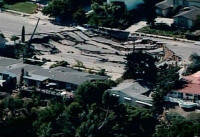|
 Hill
collapse destroys San Diego homes Hill
collapse destroys San Diego homes
 Send a link to a friend
Send a link to a friend
[October 04, 2007]
SAN DIEGO (AP) -- Holli Weld was taking one of her sons to preschool when the street gave way under their feet. "It was sinking as I was walking by," she said. "The street was sinking before our eyes." She was witnessing a landslide that collapsed a swath of ground in one of the city's swankiest neighborhoods, destroying two homes, damaging several others and leaving a major street closed.
[click on picture for larger image]
|
|
 No one was hurt in Wednesday's slide, but more than 100 homes in the hilltop La Jolla neighborhood of San Diego were evacuated as authorities braced for further earth movement. No one was hurt in Wednesday's slide, but more than 100 homes in the hilltop La Jolla neighborhood of San Diego were evacuated as authorities braced for further earth movement.
The landslide cut a 50-yard-long chasm in a four-lane street and left a 20-foot-deep ravine overlooking Interstate 5 hundreds of feet below.
City officials just one day earlier had warned residents of four homes not to sleep in them because the land might give way. It wasn't clear if those residents heeded the warnings.
The neighborhood, which comprises many million-dollar homes, is in an area that has a history of landslides dating back to the 1960s.
Orange traffic cones and sections of big concrete pipes sat in the fissure across the crumpled residential street, which serves as a busy shortcut between the surf neighborhood of Pacific Beach to the south and the fancy enclave of restaurants and shops in downtown La Jolla, a major tourist draw.

Authorities said most residents had gone to work and only seven people were inside homes near the collapse when it occurred.
Mayor Jerry Sanders declared a state of emergency Wednesday night, making the city eligible for state and federal aid.
The city began noticing cracks on Soledad Mountain Road in July and water and gas main breaks in August. A water line in the neighborhood was replaced with an above-ground pipeline in September to avert damage from the moving earth.

Sanders defended the city against charges by some residents that it didn't do enough after noticing the street cracks in July.
"We have been working with people in the most immediately affected areas since July," Sanders said at a news conference. "We have contacted the most immediately affected people over and over and over again."
[to top of second column] |
 Many homes that weren't in the immediate slide zone were yellow-tagged
-- meaning that occupants could come and go, but not stay overnight.
Rob Hawk, a city engineering geologist, said most movement had already occurred, but extra slippage is possible. "The current slide has basically come to a rest," Hawk said.
A firm hired by the city last month was in the area in the hours before the collapse installing measuring devices after a large section of slope on Mount Soledad began to slip, Hawk said.
After the outside firm advised that some residents should not stay overnight in their homes, the city sent letters to residents on Monday, and on Tuesday sent officials to four homes that now border the collapse, Hawk said.
The landslide sent earth sliding down into backyards of houses in the street below, Hawk said. "It is fairly well-defined and localized," Hawk said.
Weld packed up her car and took her two children to her parents' house in Pasadena, near Los Angeles, after city officials said her family couldn't sleep in their house on the opposite side of the street from the collapse.
At least three significant hill slides have occurred in the area from 1961 to 1994, including a major failure in 1961 that destroyed seven homes under construction.
[Associated Press; by Allison
Hoffman]
Associated Press writer Elliot Spagat contributed to this story in San Diego.
Copyright 2007 The Associated Press. All rights reserved. This
material may not be published, broadcast, rewritten or
redistributed.
 |